Novel and Efficient Synthesis of Phenethyl Formate via Enzymatic Esterification of Formic Acid
Abstract
1. Introduction
2. Materials and Methods
2.1. Materials
2.2. Standard Reaction Conditions
2.3. Reaction Condition Optimization
2.4. Enzyme Reuse
2.5. Analytical Method
3. Results and Discussion
3.1. Enzyme Selection
3.2. Enzyme Concentration
3.3. Molar Ratio of Formic Acid to Phenethyl Alcohol
3.4. Reaction Temperature
3.5. Solvent Selection According to Log P
3.6. Enzyme Reuse
4. Conclusions
Author Contributions
Funding
Conflicts of Interest
References
- Groher, A.; Weuster-Botz, D. Comparative reaction engineering analysis of different acetogenic bacteria for gas fermentation. J. Biotechnol. 2016, 228, 82–94. [Google Scholar] [CrossRef] [PubMed]
- Dürre, P. Gas fermentation – a biotechnological solution for today’s challenges. Microb. Biotechnol. 2017, 10, 14–16. [Google Scholar] [CrossRef] [PubMed]
- Mazumder, T.K.; Nishio, N.; Nagai, S. Carbon monoxide conversion to formate by Methanosarcina barkeri. Biotechnol. Lett. 1985, 7, 377–382. [Google Scholar] [CrossRef]
- Janssen, L.M.G.; van Oosten, R.; Paul, C.E.; Arends, I.W.C.E.; Hollmann, F. Lipase-catalyzed transesterification of ethyl formate to octyl formate. J. Mol. Catal. B-Enzym. 2014, 105, 7–10. [Google Scholar] [CrossRef]
- Park, H.J.; Lee, J.C. Efficient and solvent-free preparation of formate esters from alcohols under microwave irradiation. Bull. Korean Chem. Soc. 2008, 29, 856–858. [Google Scholar] [CrossRef]
- Molbase. Available online: http://www.molbase.com (accessed on 10 May 2019).
- Fernández, I.; Garcia, B.; Muñoz, S.; Pedro, J.R.; de la Salud, R. A simple convenient procedure for the synthesis of formate esters and alkyl iodides from alcohols using the system thionyl chloride-dimethylformamide-alkaline iodide. Synlett 1993, 1993, 489–490. [Google Scholar] [CrossRef]
- Kotel’nikova, T.S.; Voronina, S.G.; Perkel’, A.L. Formation of formic acid and cyclohexyl formate in oxidation of cyclohexane. Russ. J. Appl. Chem. 2006, 79, 416–420. [Google Scholar] [CrossRef]
- Murdanoto, A.P.; Sakai, Y.; Sembiring, L.; Tani, Y.; Kato, N. Ester synthesis by NAD+-dependent dehydrogenation of hemiacetal: Production of methyl formate by cells of methylotrophic yeasts. Biosci. Biotechnol. Biochem. 2014, 61, 1391–1393. [Google Scholar] [CrossRef]
- Metaxas, I.; Vasilikogiannaki, E.; Stratakis, M. Synthesis of formate esters and formamides using an Au/TiO2-catalyzed aerobic oxidative coupling of paraformaldehyde. Nanomaterials 2017, 7, 440. [Google Scholar] [CrossRef]
- Yadav, G.D.; Devendran, S. Lipase catalyzed synthesis of cinnamyl acetate via transesterification in non-aqueous medium. Process Biochem. 2012, 47, 496–502. [Google Scholar] [CrossRef]
- SÁ, A.G.A.; de Meneses, A.C.; de Araújo, P.H.H.; de Oliveira, D. A review on enzymatic synthesis of aromatic esters used as flavor ingredients for food, cosmetics and pharmaceuticals industries. Trends Food Sci. Technol. 2017, 69, 95–105. [Google Scholar] [CrossRef]
- McGinty, D.; Letizia, C.S.; Api, A.M. Fragrance material review on phenethyl formate. Food Chem. Toxicol. 2012, 50, 425–429. [Google Scholar] [CrossRef] [PubMed]
- Global Industry Analysis Inc. Recovery in Consumer Spending and Growing Focus on Personal Grooming to Drive Growth in the Global Fragrances and Perfumes Market. Available online: https://www.strategyr.com/MarketResearch/Fragrances_and_Perfumes_Market_Trends.asp (accessed on 10 May 2019).
- Khan, N.R.; Rathod, V.K. Enzyme catalyzed synthesis of cosmetic esters and its intensification: A review. Process Biochem. 2015, 50, 1793–1806. [Google Scholar] [CrossRef]
- Sun, S.; Tian, L.; Hu, B.; Jiang, C. Enzymatic synthesis of lipophilic caffeoyl lipids using soybean oil as the novel acceptor. Biotechnol. Bioprocess Eng. 2018, 23, 557–563. [Google Scholar] [CrossRef]
- Adlercreutz, P. Immobilisation and application of lipases in organic media. Chem. Soc. Rev. 2013, 42, 6406–6436. [Google Scholar] [CrossRef] [PubMed]
- Krishna, S.H.; Divakar, S.; Prapulla, S.G.; Karanth, N.G. Enzymatic synthesis of isoamyl acetate using immobilized lipase from Rhizomucor miehei. J. Biotechnol. 2001, 87, 193–201. [Google Scholar] [CrossRef]
- Wang, Y.; Zhang, D.-H.; Chen, N.; Zhi, G.-Y. Synthesis of benzyl cinnamate by enzymatic esterification of cinnamic acid. Bioresour. Technol. 2015, 198, 256–261. [Google Scholar] [CrossRef]
- Kim, H.; Park, C. Enzymatic synthesis of phenethyl ester from phenethyl alcohol with acyl donors. Enzyme Microb. Technol. 2017, 100, 37–44. [Google Scholar] [CrossRef]
- Woo, H.S.; Shin, S.; Lee, H.-S.; Yoon, T.J.; Lee, Y.-W. Acid-catalyzed regeneration of fatty-acid-adsorbed γ-alumina via transesterification with methanol. Korean J. Chem. Eng. 2018, 35, 1994–2000. [Google Scholar] [CrossRef]
- The RIFM Expert Panel; Belsito, D.; Bickers, D.; Bruze, M.; Calow, P.; Dagli, M.L.; Fryer, A.D.; Greim, H.; Miyachi, Y.; Saurat, J.H.; et al. A toxicological and dermatological assessment of aryl alkyl alcohol simple acid ester derivatives when used as fragrance ingredients. Food Chem. Toxicol. 2012, 50, 269–313. [Google Scholar]
- Evans, L. New law in the EU. European Food and Feed Law Review 2017, 12, 49–51. Available online: https://effl.lexxion.eu/article/EFFL/2017/1/9.
- Park, D.-W.; Haam, S.; Ahn, I.-S.; Lee, T.G.; Kim, H.-S.; Kim, W.-S. Enzymatic esterification of β–methylglucoside with acrylic/methacrylic acid in organic solvents. J. Biotechnol. 2004, 107, 151–160. [Google Scholar] [CrossRef] [PubMed]
- Ortiz, C.; Ferreira, M.L.; Barbosa, O.; dos Santos, J.C.; Rodrigues, R.C.; Berenguer-Murcia, Á.; Briand, L.E.; Fernandez-Lafuente, R. Novozym 435: The “perfect” lipase immobilized biocatalyst? Catal. Sci. Technol. 2019, 9, 2380–2420. [Google Scholar] [CrossRef]
- Zhang, X.; Li, L.; Huang, J.R.; Chen, L.; Li, X.X.; Liu, G.Q.; Li, B. Enzymatic synthesis of naringin palmitate. Adv. Mater. Res. 2012, 554, 1350–1356. [Google Scholar] [CrossRef]
- Yahya, A.R.; Anderson, W.A.; Moo-Young, M. Ester synthesis in lipase-catalyzed reactions. Enzyme Microb. Technol. 1998, 23, 438–450. [Google Scholar] [CrossRef]
- Sun, W.J.; Zhao, H.X.; Cui, F.J.; Li, Y.H.; Yu, S.L.; Zhou, Q.; Qian, J.Y.; Dong, Y. D-isoascorbyl palmitate: Lipase-catalyzed synthesis, structural characterization and process optimization using response surface methodology. Chem. Cent. J. 2013, 7, 114. [Google Scholar] [CrossRef][Green Version]
- Rodrigues, R.C.; Fernandez-Lafuente, R. Lipase from Rhizomucor miehei as a biocatalyst in fats and oils modification. J. Mol. Catal. B-Enzym. 2010, 66, 15–32. [Google Scholar] [CrossRef]
- Zhang, Y.; Vongvilai, P.; Sakulsombat, M.; Fischer, A.; Ramstrcm, O. Asymmetric synthesis of substituted thiolanes through domino Thia-Michael–Henry dynamic covalent systemic resolution using lipase catalysis. Adv. Synth. Catal. 2014, 356, 987–992. [Google Scholar] [CrossRef]
- Li, K.; Wang, J.; He, Y.; Cui, G.; Abdulrazaq, M.A.; Yan, Y. Enhancing enzyme activity and enantioselectivity of Burkholderia cepacia lipase via immobilization on melamine-glutaraldehyde dendrimer modified magnetic nanoparticles. Chem. Eng. J. 2018, 351, 258–268. [Google Scholar] [CrossRef]
- Poojari, Y.; Clarson, S.J. Thermal stability of Candida antarctica lipase B immobilized on macroporous acrylic resin particles in organic media. Biocatalysis Agric. Biotech. 2013, 2, 7–11. [Google Scholar] [CrossRef]
- Abdulmaleka, E.; Saupia, H.S.M.; Tejoa, B.A.; Basria, M.; Sallehb, A.B.; Rahmanb, R.N.Z.R.A.; Rahman, M.B.A. Improved enzymatic galactose oleate ester synthesis in ionic liquids. J. Mol. Catal. B-Enzym. 2012, 76, 37–43. [Google Scholar] [CrossRef]
- Rodrigues, R.C.; Fernandez-Lafuente, R. Lipase from Rhizomucor miehei as an industrial biocatalyst in chemical process. J. Mol. Catal. B-Enzym. 2010, 64, 1–22. [Google Scholar] [CrossRef]
- Inagaki, M.; Hiratake, J.; Nishioka, T.; Junichi, O. Lipase-catalyzed stereoselective acylation of [1,1’-binaphthyl]-2,2′-diol and deacylation of Its esters in an organic solvent. Agric. Biol. Chem. 1989, 53, 1879–1884. [Google Scholar]
- Zhang, H.Y.; Wang, X.; Ching, C.B. R-Stereopreference analysis of lipase Novozym 435 in kinetic resolution of flurbiprofen. Chirality 2007, 19, 245–249. [Google Scholar] [CrossRef]
- Zong, M.-H.; Wu, H.; Tan, Z.-y. Substantially enhancing enzymatic regioselective acylation of 1-β-D-arabinofuranosylcytosine with vinyl caprylate by using a co-solvent mixture of hexane and pyridine. Chem. Eng. J. 2008, 144, 75–78. [Google Scholar] [CrossRef]
- Abdulmaleka, E.; Hamidon, N.F.; Rahman, M.B.A. Optimization and characterization of lipase catalysed synthesis of xylose caproate ester in organic solvents. J. Mol. Catal. B-Enzym. 2016, 132, 1–4. [Google Scholar] [CrossRef]
- Yadav, G.D.; Devi, K.M. Immobilized lipase-catalysed esterification and transesterification reactions in non-aqueous media for the synthesis of tetrahydrofurfuryl butyrate: Comparison and kinetic modeling. Chem. Eng. Sci. 2004, 59, 373–383. [Google Scholar] [CrossRef]
- Reis, P.; Holmberg, K.; Watzke, H.; Leser, M.E.; Miller, R. Lipases at interfaces: A review. Adv. Colloid Interface Sci. 2009, 147, 237–250. [Google Scholar] [CrossRef]
- Stergiou, P.-Y.; Foukis, A.; Filippou, M.; Koukouritaki, M.; Parapouli, M.; Theodorou, L.G.; Hatziloukas, E.; Afendra, A.; Pandey, A.; Papamichael, E.M. Advances in lipase-catalyzed esterification reactions. Biotechnol. Adv. 2013, 31, 1846–1859. [Google Scholar] [CrossRef]
- Yadav, G.D.; Lathi, P.S. Kinetics and mechanism of synthesis of butyl isobutyrate over immobilised lipases. Biochem. Eng. J. 2003, 16, 245–252. [Google Scholar] [CrossRef]
- Duan, G.; Ching, C.B.; Lim, E.; Ang, C.H. Kinetic study of enantioselective esterification of ketoprofen with n-propanol catalysed by a lipase in an organic medium. Biotechnol. Lett. 1997, 19, 1051–1055. [Google Scholar] [CrossRef]
- Yadav, G.D.; Trivedi, A.H. Kinetic modeling of immobilized-lipase catalyzed transesterification of n-octanol with vinyl acetate in non-aqueous media. Enzyme Microb. Technol. 2003, 32, 783–789. [Google Scholar] [CrossRef]
- Wehtje, E.; Kaur, J.; Adlercreutz, P.; Chand, S.; Mattiasson, B. Water activity control in enzymatic esterification processes. Enzyme Microb. Technol. 1997, 21, 502–510. [Google Scholar] [CrossRef]
- Labuza, T.P.; Kaanane, A.; Chen, J.Y. Effect of temperature on the moisture sorption isotherms and water activity shift of two dehydrated foods. J. Food Sci. 1985, 50, 385–391. [Google Scholar] [CrossRef]
- Wang, Y.; Zhang, D.-H.; Zhang, J.-Y.; Chen, N.; Zhi, G.-Y. High-yield synthesis of bioactive ethyl cinnamate by enzymatic esterification of cinnamic acid. Food Chem. 2016, 190, 233–629. [Google Scholar] [CrossRef] [PubMed]
- Kartal, F. Enhanced esterification activity through interfacial activation and cross-linked immobilization mechanism of Rhizopus oryzae lipase in a nonaqueous medium. Biotechnol. Prog. 2016, 32, 899–904. [Google Scholar] [CrossRef] [PubMed]
- Li, C.; Zhang, F.; Gao, Z.; He, L.; Zeng, X.; Zhu, Q.; Yu, L. Effects of organic solvent, water activity, and salt hydrate pair on the sn-1,3 selectivity and activity of whole-cell lipase from Aspergillus niger GZUF36. Appl. Microbiol. Biotechnol. 2017, 102, 225–235. [Google Scholar] [CrossRef]
- Fu, B.; Vasudevan, P.T. Effect of solvent-co-solvent mixtures on lipase-catalyzed transesterification of canola oil. Energy Fuel. 2010, 24, 4646–4651. [Google Scholar] [CrossRef]
- Kamal, M.Z.; Yedavalli, P.; Deshmukh, M.V.; Rao, N.M. Lipase in aqueous-polar organic solvents: Activity, structure, and stability. Protein Sci. 2013, 22, 904–915. [Google Scholar] [CrossRef]
- Gumel, A.M.; Annuar, M.S.M.; Heidelberg, T.; Chisti, Y. Lipase mediated synthesis of sugar fatty acid esters. Process Biochem. 2011, 46, 2079–2090. [Google Scholar] [CrossRef]
- Kumar, A.; Dhar, K.; Kanwar, S.S.; Arora, P.K. Lipase catalysis in organic solvents: Advantages and applications. Biol. Proced. Online. 2016, 18, 1–11. [Google Scholar] [CrossRef] [PubMed]
- Manoel, E.A.; Pais, K.C.; Cunha, A.G.; Simas, A.B.C.; Coelho, M.A.Z.; Freire, D.M.G. Kinetic Resolution of 1,3,6-Tri-O-benzyl-myo-Inositol by Novozym 435: Optimization and enzyme reuse. Org. Process Res. Dev. 2012, 16, 1378–1384. [Google Scholar] [CrossRef]
- Valivety, R.H.; Johnston, G.A.; Suckling, C.J.; Halling, P.J. Solvent effects on biocatalysis in organic systems: Equilibrium position and rates of lipase catalyzed esterification. Biotechnol. Bioeng. 1991, 38, 1137–1143. [Google Scholar] [CrossRef] [PubMed]
- Liu, Y.; Zhang, X.; Tan, H.; Yan, Y.; Hameed, B.H. Effect of pretreatment by different organic solvents on esterification activity and conformation of immobilized Pseudomonas cepacia lipase. Process Biochem. 2010, 45, 1176–1180. [Google Scholar] [CrossRef]
- Reichardt, C. Solvents and solvent effects in organic chemistry, 3rd ed.; WILEY-VCH: Weinheim, Germany, 2004. [Google Scholar]
- Lee, F.M.; Wytcherley, R.W. Azeotropic Distillation; Academic Press: Cambridge, MA, USA, 2000; pp. 990–995. Available online: http://index-of.co.uk/Tutorials-2/Azeotropic%20Distillation.pdf (accessed on 13 December 2019).
- Yamamura, R.; Shimomura, Y. Industrial high-performance liquid chromatography purification of docosahexaenoic acid ethyl ester and docosapentaenoic acid ethyl ester from single-cell oil. J. Am. Oil Chem. Soc. 1997, 74, 1435–1440. [Google Scholar] [CrossRef]
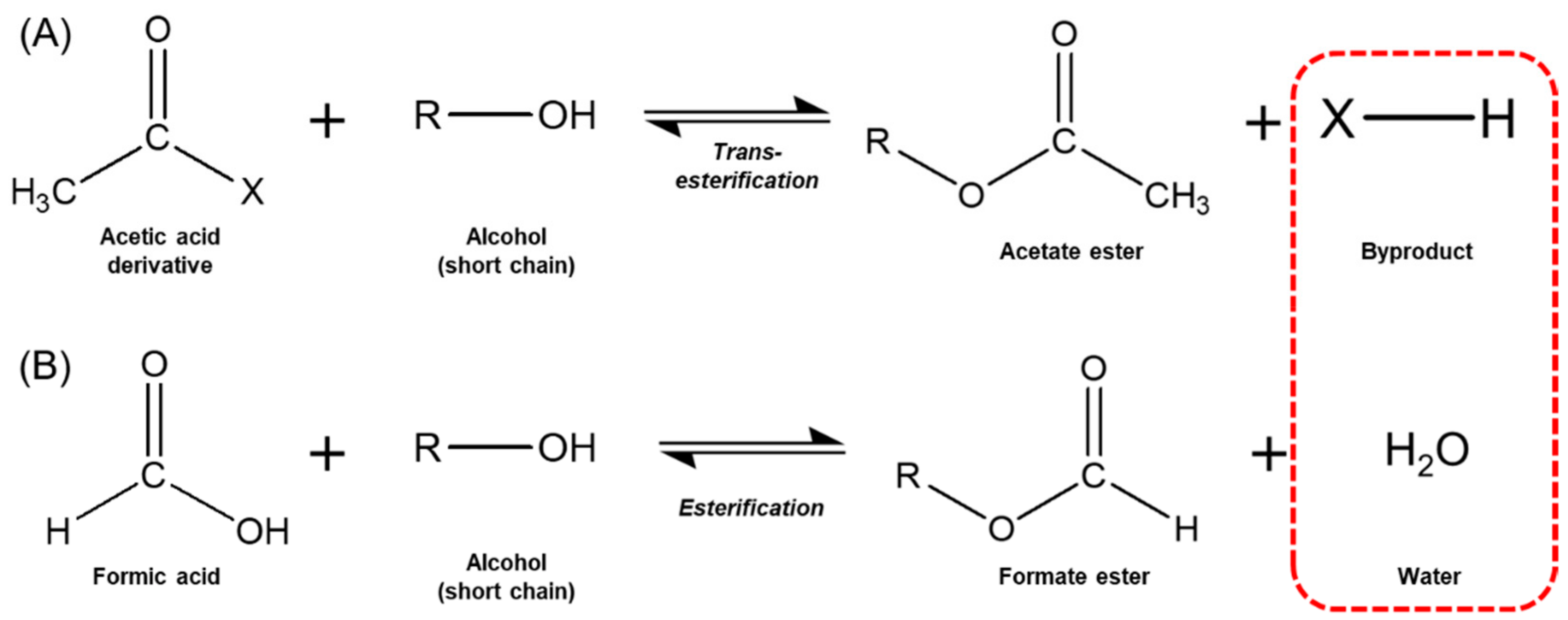
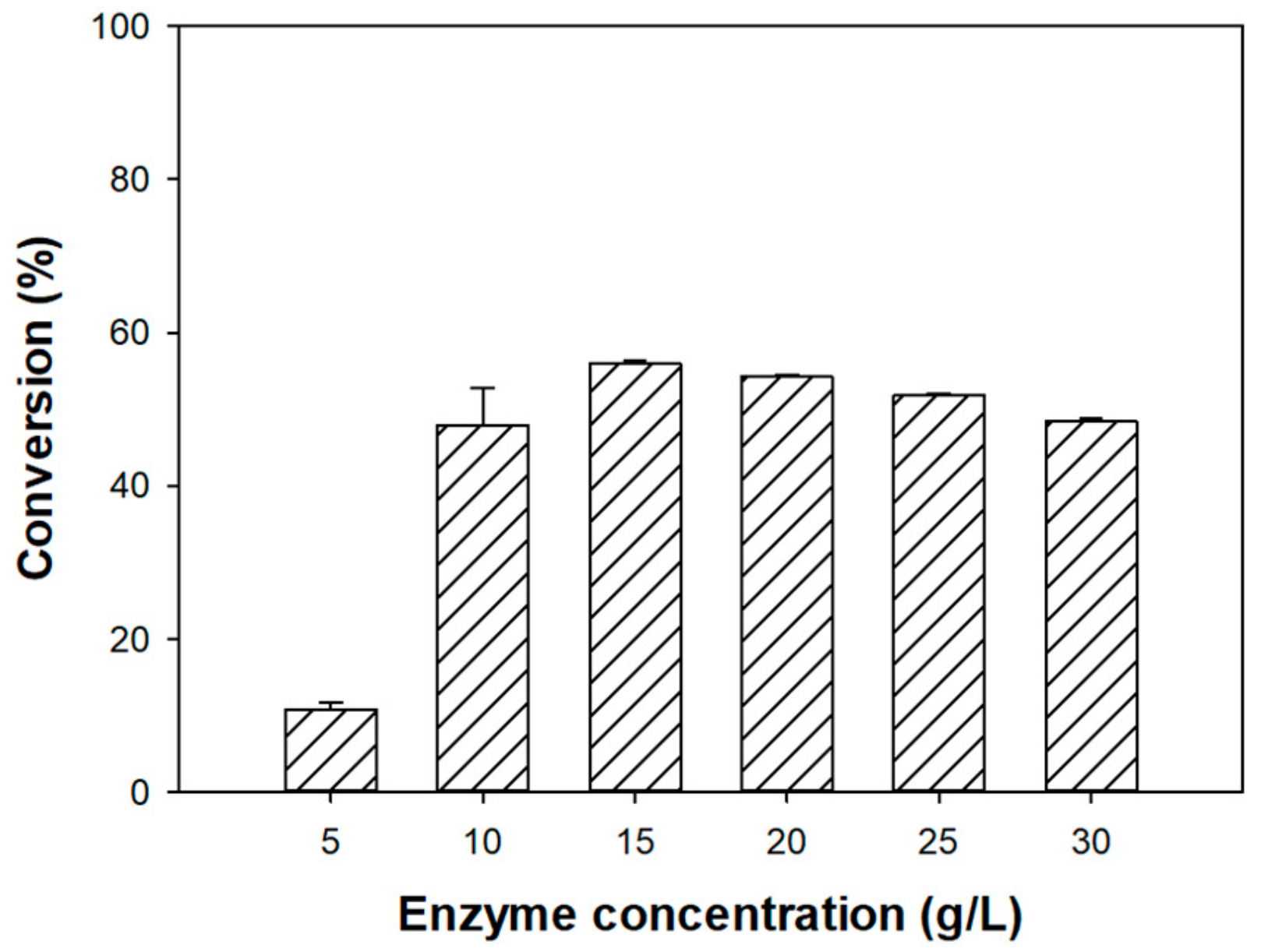
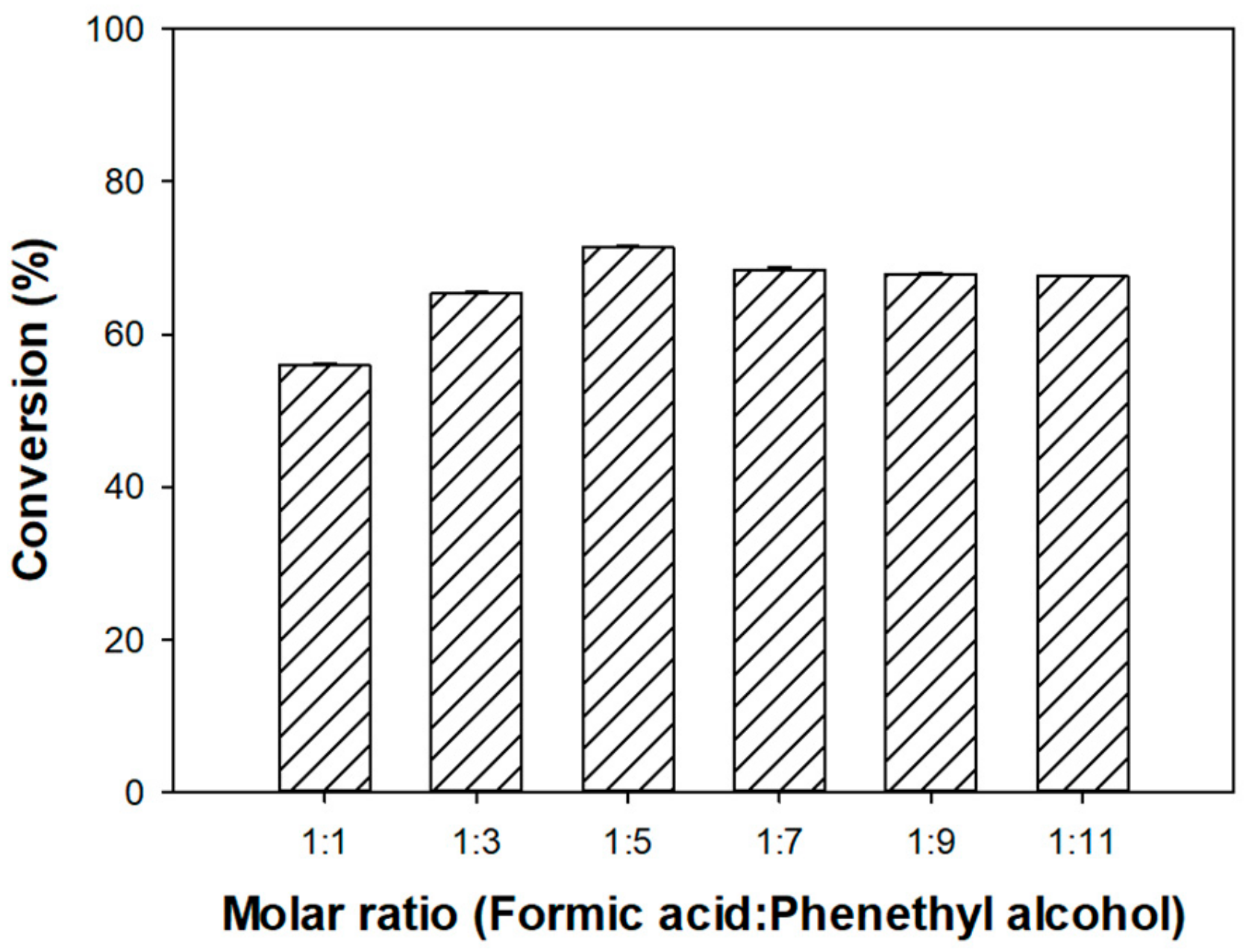
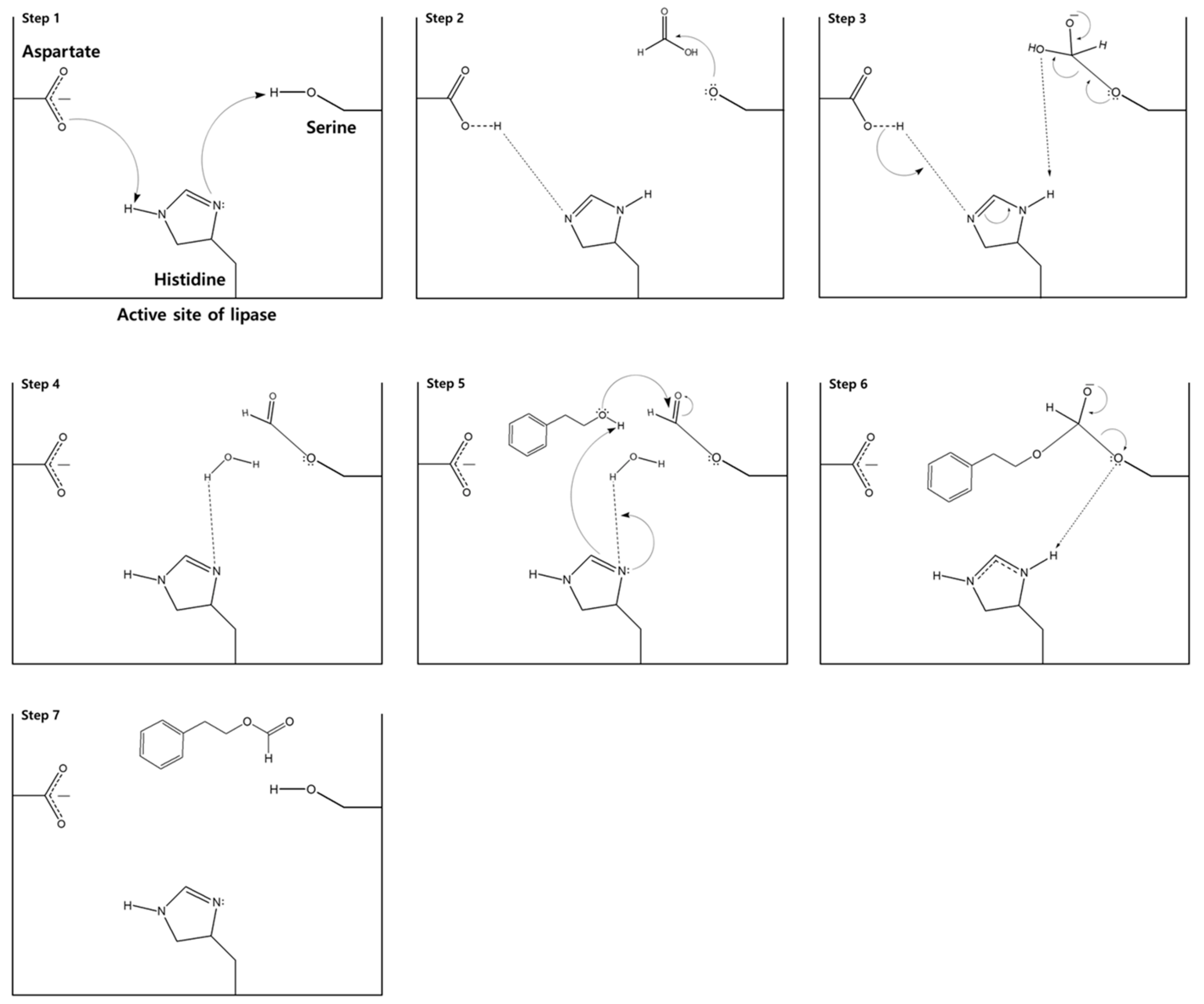
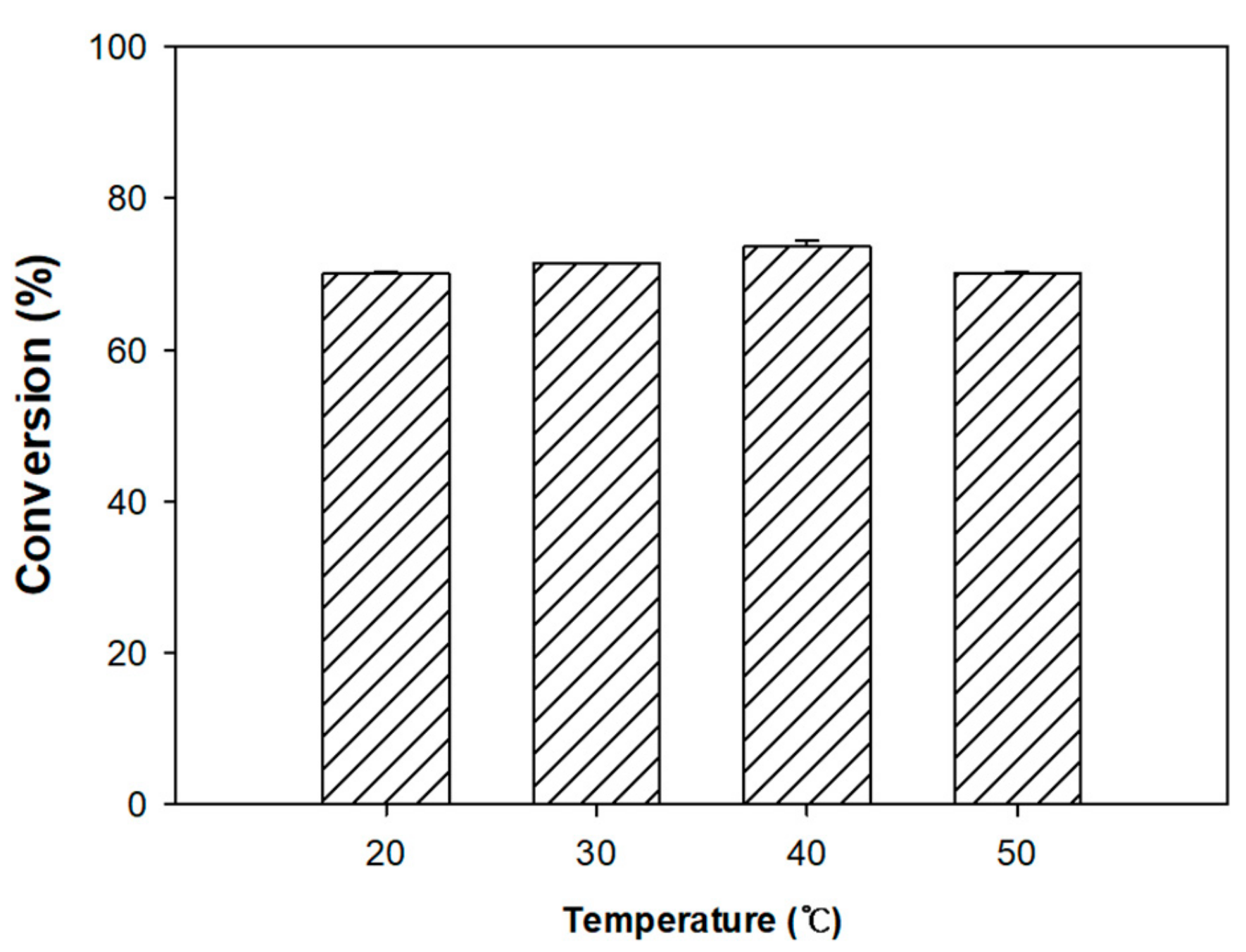
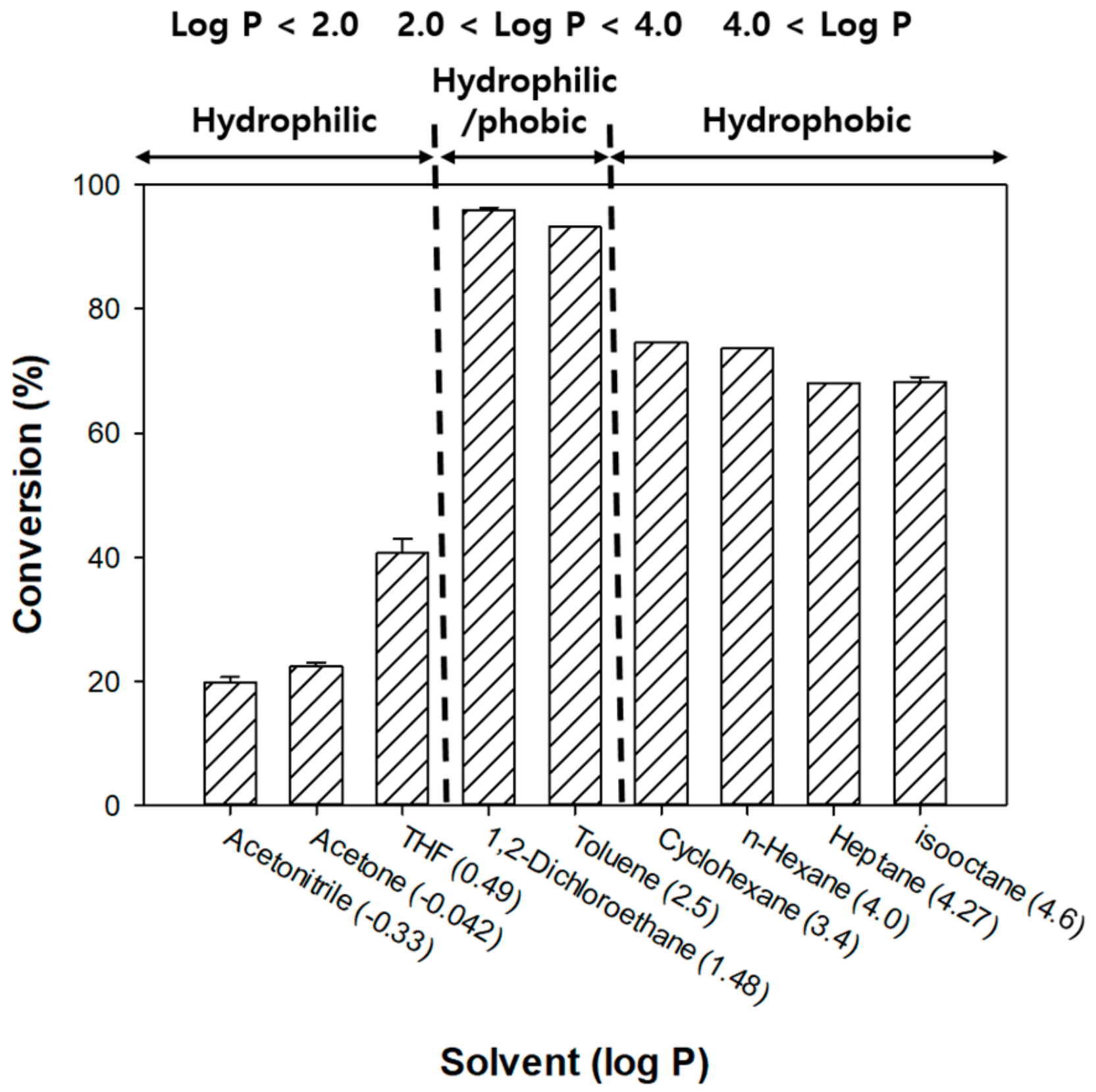
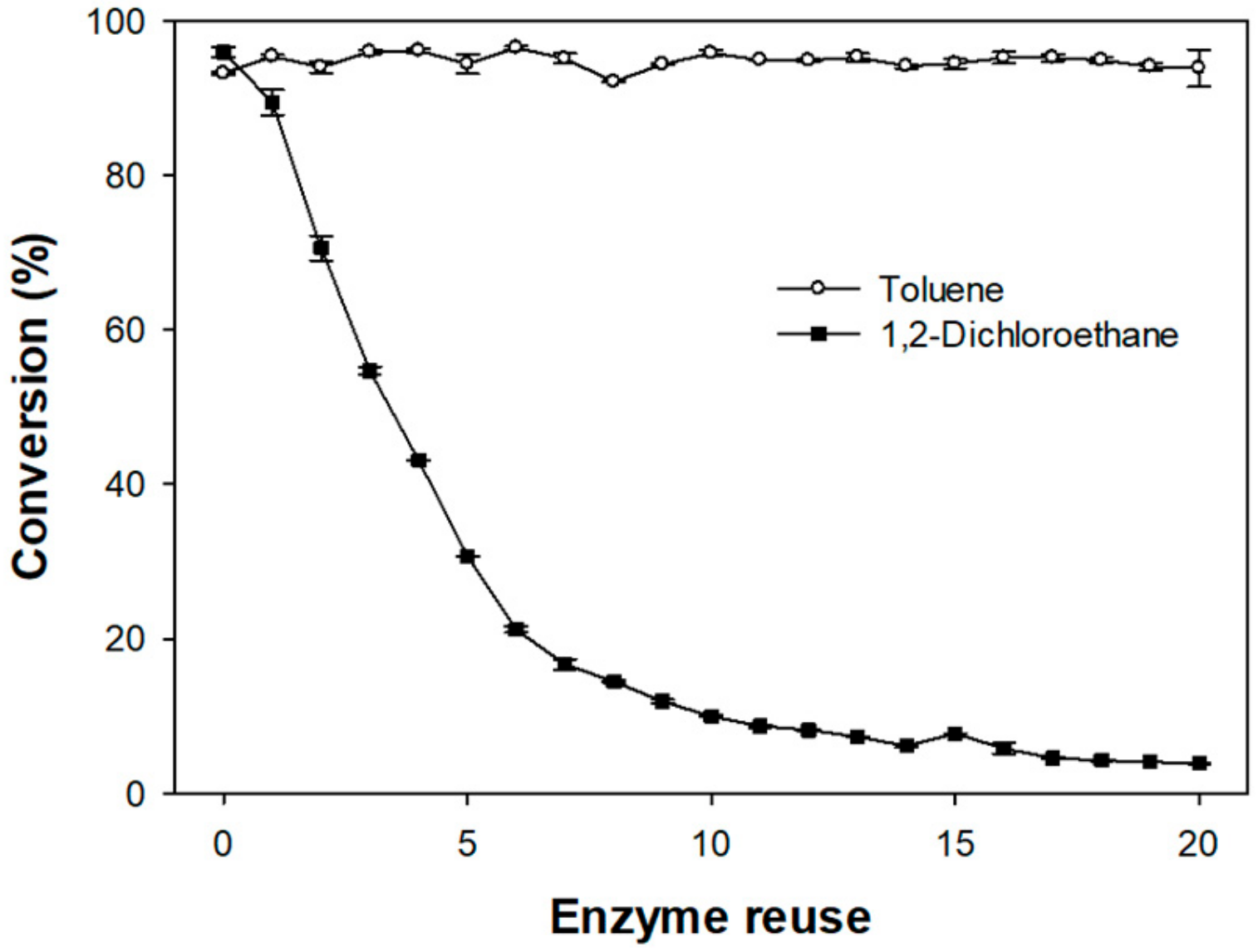
| Alcohol | Product | Synthetic Method | Reaction Time | Reaction Conditions | Yield (Conversion) | Reference |
|---|---|---|---|---|---|---|
| n-hexanol; | Hexyl formate; | Microwave irradiation | 160 s | PTSA in CH2Cl2 | 77% | [5] |
| Benzyl alcohol; | Benzyl formate; | 220 s | 85% | |||
| Phenethyl alcohol | Phenethyl formate | 180 s | 81% | |||
| Myristyl alcohol; | Myristyl formate; | Formylation | 0.5 h | Reaction between thionyl chloride and DMF; Temp.: 0 °C | 95% | [7] |
| Undecyl alcohol | Undecyl formate | 96% | ||||
| Cyclohexanol | Cyclohexyl formate | Oxidation | 1 h | Temperature (Temp.): 90 °C | 45% | [8] |
| Methanol | Methyl formate | Methylotrophic yeast | 90 h | NAD+-dependent dehydrogenation | 90% | [9] |
| 1-octanol; | Octyl formate; | Aerobic oxidation | 10 h | Reaction between Catalytic Au/TiO2 and p-formaldehyde; Temp.: 80 °C | 80% | [10] |
| Cyclohexanol; | Cyclohexyl formate; | 90% | ||||
| Benzyl alcohol | Benzyl formate | 55% | ||||
| 1-octanol | Octyl formate | Enzymatic | 24 h | Transesterification reaction with an ethyl formate:1-octanol molar ratio of 94:6 | 90% | [4] |
| Immobilized Lipase | Specificity/Selectivity | Immobilization Support | Conversion 1 |
|---|---|---|---|
| Novozym 435 | Nonspecific | Acrylic resin (Lewatit vp oc 1600) | 47.83% |
| Lipozyme RM IM | 1,3-specific | Phenol–formaldehyde copolymer (Duolite ES 562) | 0.28% |
| Lipozyme TL IM | 1,3-specific | Silica gel | 0.34% |
| Lipase PS Amano IM | Stereoselective acylation | Diatomaceous earth | 0.60% |
© 2020 by the authors. Licensee MDPI, Basel, Switzerland. This article is an open access article distributed under the terms and conditions of the Creative Commons Attribution (CC BY) license (http://creativecommons.org/licenses/by/4.0/).
Share and Cite
Shin, M.; Seo, J.; Baek, Y.; Lee, T.; Jang, M.; Park, C. Novel and Efficient Synthesis of Phenethyl Formate via Enzymatic Esterification of Formic Acid. Biomolecules 2020, 10, 70. https://doi.org/10.3390/biom10010070
Shin M, Seo J, Baek Y, Lee T, Jang M, Park C. Novel and Efficient Synthesis of Phenethyl Formate via Enzymatic Esterification of Formic Acid. Biomolecules. 2020; 10(1):70. https://doi.org/10.3390/biom10010070
Chicago/Turabian StyleShin, Minguk, Jeongbae Seo, Yesol Baek, Taek Lee, Min Jang, and Chulhwan Park. 2020. "Novel and Efficient Synthesis of Phenethyl Formate via Enzymatic Esterification of Formic Acid" Biomolecules 10, no. 1: 70. https://doi.org/10.3390/biom10010070
APA StyleShin, M., Seo, J., Baek, Y., Lee, T., Jang, M., & Park, C. (2020). Novel and Efficient Synthesis of Phenethyl Formate via Enzymatic Esterification of Formic Acid. Biomolecules, 10(1), 70. https://doi.org/10.3390/biom10010070







